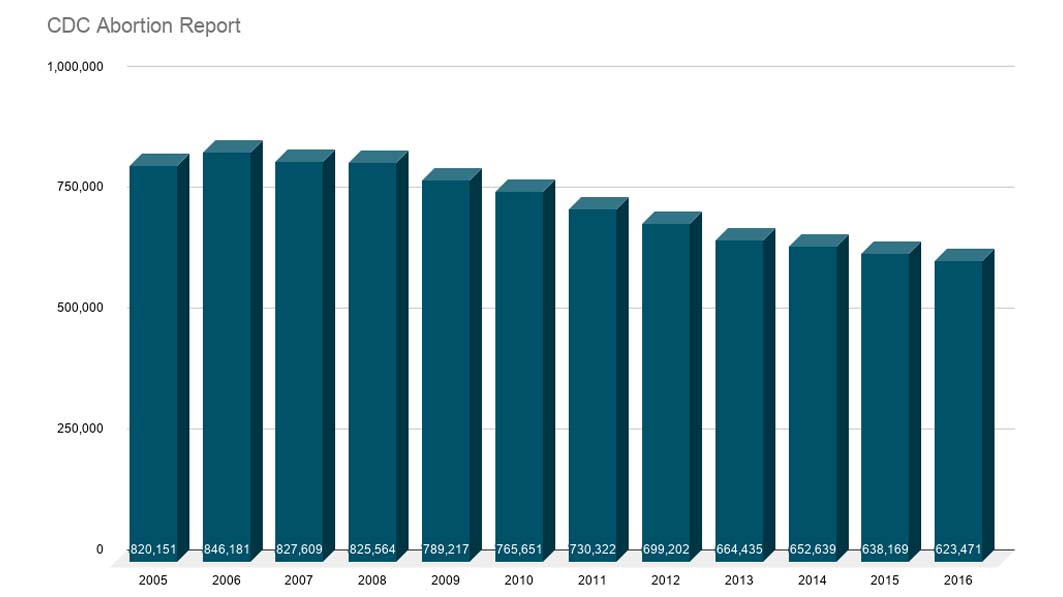Every year, the Centers for Disease Control and Prevention (CDC) releases the Abortion Surveillance report. It details, as much as possible, what abortion currently looks like in the United States (although the data is three years old). While there is a lot of good news out of the CDC’s study, there are many concerning trends as well. Last week, The Daily Citizen detailed what the report meant for the future of Planned Parenthood, but here are some of the other details from the report and what it means for Americans and the pro-life cause.
Overall, abortion numbers are down by 24% since 2005, falling to 623,471 in 2016 (minus reporting from California, Maryland, New Hampshire and the District of Columbia). That’s great news for pro-life supporters. Some of this could be the result of a natural demographics shift in the United States as the birth rate has fallen to record lows, but it is nonetheless a positive development.
The report also revealed that abortion is generally decreasing in pro-abortion states, like Colorado and New York, while it is increasing in some pro-life states like Alabama, Arizona, Georgia and Missouri. The result seems odd, especially considering the very public battles over pro-life legislation in Alabama, Georgia and Missouri this year.
In Georgia’s case, the state proudly passed a heartbeat bill in May, despite pushback from Hollywood. However, the state also has one of the country’s highest abortion rates at 15.9 (the number of abortions per 1,000 women aged 15-44 years). It’s the third highest rate in the country behind New York at 21.8 and Florida at 18.5. Georgia is also one of few states where the number of abortions is increasing. In 2016, the number of abortions in the state was trending up to nearly 30,000. That’s a 10% increase from the previous year.
Earlier this year, the state of Alabama signed the nation’s most restrictive abortion bill into law It’s much needed. The number of abortions has reached almost 7,000 compared to only 6,618 the previous year, which is an increase of 5.5%. Arizona’s has experienced a similar growth in the number of abortions, although that may partly be attributed to its growing population.
A bright spot is Oklahoma, where there was an 8% decrease in the number of abortions between 2015-2016. In the same period, Wyoming had a 18% decrease.
Oddly, typically liberal states like New York, Delaware and Colorado have seen fairly substantial decreases in the number of abortions. Earlier this year, New York shocked the country when the legislature passed a bill that would make abortion legal until birth. It’s ironic considering that abortion is on a downward trend in the state from a high of 118,861 in 2005 to 82,841 in 2016, a decrease of 30%. Still far too high, but it is good to see fewer women choosing abortion in one of the nation’s most populous states and again signals that the New York law was entirely unnecessary.
There’s also Colorado, home of infamous late-term abortionist Warren Hern. In this state, abortions are down from 8,975 to 7,363 in 2016, a staggering 18% decrease in one year. Delaware had a 13% decrease in one year.
Some other good news is that there are fewer teenagers and young women having abortions or getting pregnant at all.
Perhaps the most troubling bit of news is that the use of abortion pills, also known as a chemical or medical abortion, is becoming increasingly popular. According to the report, in the first eight weeks of pregnancy use of the abortion pill grew by 18%, and between 9-13 weeks it grew by a staggering 91%. The use of the abortion pill later in pregnancy is especially concerning since doctors have determined it is most effective by the 10th week of pregnancy. That women are prescribed it afterwards, in some cases up to the 21 weeks of pregnancy and increasing the chance of an incomplete abortion and complications, could be considered medically negligent.
Although abortion numbers are down, the fight for life isn’t over. There were still 623,471 abortions last year (include the numbers from Guttmacher Institute of states that didn’t report and the number jumps to 793,791 abortions). It’s an improvement from previous years , but that’s still far too many abortions.
That’s why it’s important to talk to your family about the importance of life and consider attending an event like Alive 2020.






